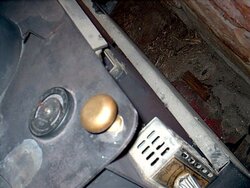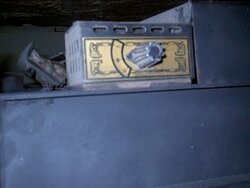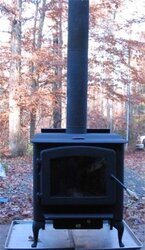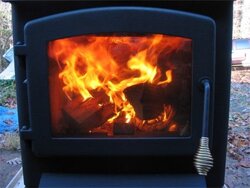Well, had another fire. This stove is so goofy!
On a suggestion from a member over at Homesteading Today (
http://www.homesteadingtoday.com/), I leveled all the ash, and built a fire right on top of it. In the absence of any real directions for building a fire in a stove with a bottom-front vent, I placed two splits as bumpers, one in back, one in front, running left-right. I filled the space between them with crumples of paper, laid kindling over those like rungs in a ladder, and laid a third, smaller split on the kindling. (My splits are typically 18" long, and 6-8" across- quarters or thirds of a trunk typically 8-10" in diameter, or similarly-sized splits off larger pieces. I have not tried whole branches 3-5" yet, as I've had bad luck getting those to go, this thing NEEDS split wood!)
It was slow to start, and I had to relight it a couple times. I think that had more to do with the orientation of the bumpers than anything, and next time I will orient them left and right, running front-back. Once it got started, it really seemed to take off, and I got a grand old fire out of it! The garage was WARM, enough to take off both hat AND coat, and snow started melting off the snowthrowers! Made for a really enjoyable time in there, but for having to stoke the fire and add wood every half hour or so.
On a couple occasions, I let the fire die back, and came back to a happy bed of coals but no burning. I laid a split in the coals and left the door 'shut to', and within a couple minutes it self-started. I left the door cracked until the temps got up to 300* or so (gauging by the Chimstat on the body of the stove), then closed the door. The fire evened out, and would run between 3-400*F.
I'm still not quite 'on' in terms of running this thing, though. It seems to eat just as much as the old Atlanta, and while the more compact body and shroud fan really make this one a winner, I somehow expected better. I think this has more to do with my dampers than anything else. I have the front damper on "H" all the time, and run the flue vent wide open. When I put the front damper to "M", the fire seems to die back very quickly, and I have to open the door to re-establish a burn.
If I leave the front damper on "H" and close the flue damper to 1/2-2/3 closed once a fire is established, it mellows the fire, and kills it just as well as closing the front damper, only more slowly. My only indication this has happened is the gradual cooling of the garage, and often the first visible note of my breath clues me in that something's wrong. When I open the stove door, a gout of smoke comes out unless I remember to open the flue damper first. If I note the dampers' positions and open the flue damper, the coals sit and smolder until I open the stove to give the logs a poke, at which point they usually spring back into flame after a short bit.
Does this sound like normal running? Am I remiss in thinking that I should be able to get an active burn, with good heat, without having to feed the stove every half hour?







 , where can you find the fiberglass insulation similar to that used for door gasketing, but is flat, to insulate on either side of the tempered glass window in the front door of my Earth Stove? A 6" section of it poked out and has been damaged, and now I don't know if it's introducing additional draft (guessing by the way the smoke moves when I close the door). The gap looks much too thin to use standard round gasketing, and I don't want to pack it with fire cement in case I ever need to replace the glass. Any suggestions?
, where can you find the fiberglass insulation similar to that used for door gasketing, but is flat, to insulate on either side of the tempered glass window in the front door of my Earth Stove? A 6" section of it poked out and has been damaged, and now I don't know if it's introducing additional draft (guessing by the way the smoke moves when I close the door). The gap looks much too thin to use standard round gasketing, and I don't want to pack it with fire cement in case I ever need to replace the glass. Any suggestions?